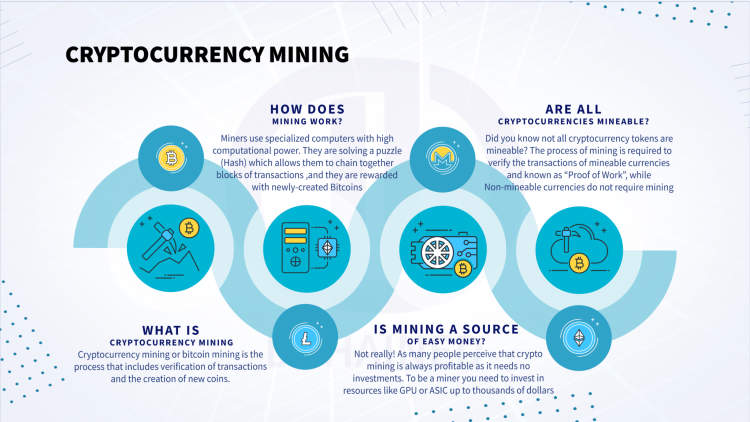Cryptocurrency mining is a process that involves verifying and recording transactions in a digital currency’s blockchain network. It serves as the backbone of various cryptocurrencies like Bitcoin and Ethereum, ensuring their security and integrity.
Miners, equipped with powerful computers, compete to solve complex mathematical problems to validate transactions and add them as blocks to the blockchain. In return for their computational efforts, miners are rewarded with new coins, providing an incentive for their participation in the mining process.
What is Cryptocurrency Mining?
Cryptocurrency mining is the process of verifying and validating transactions on a blockchain network in order to earn rewards in the form of digital currencies. It is an essential component of many decentralized cryptocurrencies, including Bitcoin and Ethereum.
In traditional fiat currencies, the central banks are responsible for issuing and regulating the circulation of money. However, in the case of cryptocurrencies, mining serves as the decentralized authority that verifies and secures the transactions.
Cryptocurrency miners use powerful computers to solve complex mathematical problems that validate the authenticity of each transaction. These miners compete against each other to be the first to solve the puzzle and add a new block of transactions to the blockchain. Once a miner successfully solves the problem, they are rewarded with a certain amount of newly minted digital coins.
Here are a few key points about cryptocurrency mining:
- Mining requires substantial computational power and energy consumption.
- It helps in maintaining the security and integrity of the blockchain network.
- The process of mining also controls the issuance of new coins, thus creating scarcity.
- As more miners join the network, the difficulty of the mathematical problems increases.
- Certain cryptocurrencies have a limited supply, making mining even more competitive.
Overall, cryptocurrency mining plays a crucial role in the functioning, security, and growth of various digital currencies. It ensures the transparency and trustworthiness of transactions within the decentralized network, enabling secure peer-to-peer transactions without the need for intermediaries.
The Process of Cryptocurrency Mining

In recent years, cryptocurrency mining has gained significant popularity as one of the most lucrative ventures in the digital world. But what exactly is cryptocurrency mining, and how does it work? Let’s delve into the process and find out.
1. Understanding Cryptocurrency
To comprehend cryptocurrency mining, it is vital to grasp the concept of cryptocurrency itself. Cryptocurrencies are decentralized digital currencies that rely on cryptography for security. Examples include Bitcoin, Ethereum, and Litecoin.
2. What Is Mining?
Mining is the process through which new cryptocurrencies are created and transactions are validated and added to the blockchain network. Miners use powerful computers to solve complex mathematical problems that secure the network and ensure its integrity.
3. Proof of Work
Most cryptocurrencies utilize a consensus mechanism called “Proof of Work” (PoW) to validate transactions. In PoW, miners compete to solve computational puzzles. The miner who solves the puzzle first is rewarded with newly created coins and transaction fees.
4. Hardware and Software
To engage in cryptocurrency mining, miners require specialized hardware and software. High-performance graphics cards (GPUs) or specialized mining hardware called ASICs (Application-Specific Integrated Circuits) are commonly used. Miners also utilize mining software to connect their hardware to the cryptocurrency network.
5. Joining a Mining Pool
Mining alone can be challenging due to increased competition and the high computational power required. Many miners choose to join mining pools where they combine their resources to increase their chances of successfully mining a block and earning rewards.
6. Energy Consumption
Cryptocurrency mining is an energy-intensive process, often requiring high electricity consumption. Miners must consider the cost of electricity and the environmental impact of their operations.
7. Future of Mining
As cryptocurrencies evolve, new mining algorithms and consensus mechanisms are being developed to make mining more efficient and environmentally friendly. Some cryptocurrencies are transitioning from PoW to Proof of Stake (PoS) or other energy-saving alternatives.
Overall, cryptocurrency mining plays a crucial role in the creation and maintenance of cryptocurrency networks. It involves complex computations, specialized hardware and software, and energy consumption. As technology advances, the mining process continues to evolve, shaping the future of cryptocurrencies.
Conclusion
Cryptocurrency mining is a crucial process that supports the functioning and security of decentralized digital currencies like Bitcoin. It involves the use of powerful computer systems to solve complex mathematical problems in order to validate transactions and add them to the blockchain. Mining not only rewards miners with new coins but also plays a vital role in maintaining the integrity and stability of the cryptocurrency network.
However, as the popularity of cryptocurrencies has grown, so has the mining difficulty and energy consumption associated with it. Many modern-day cryptocurrencies have moved away from traditional mining methods and adopted alternative consensus mechanisms like Proof of Stake, which require less computational power and energy. This shift has led to debates about the environmental impact and sustainability of cryptocurrency mining. Despite the challenges, mining continues to be an integral part of the cryptocurrency ecosystem, driving innovation and enabling the secure transfer of digital assets across the globe.

0 Komentar untuk "What Is Cryptocurrency Mining?"